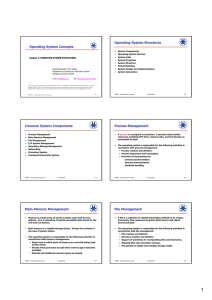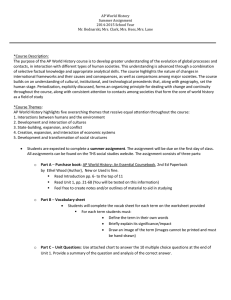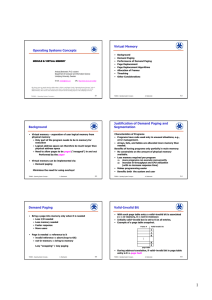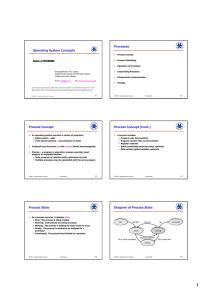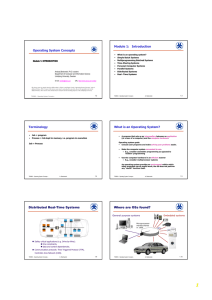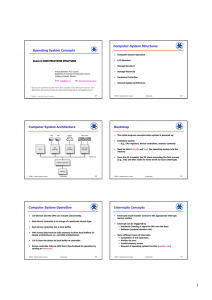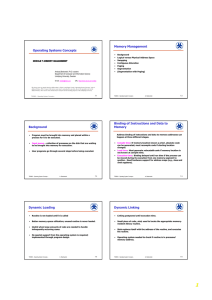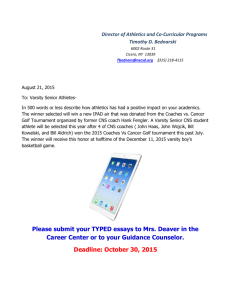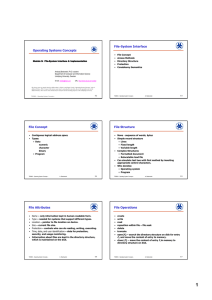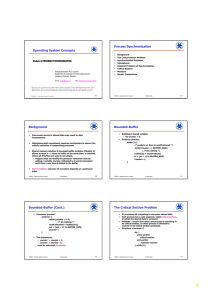Operating System Protection & Security Lecture Notes
advertisement
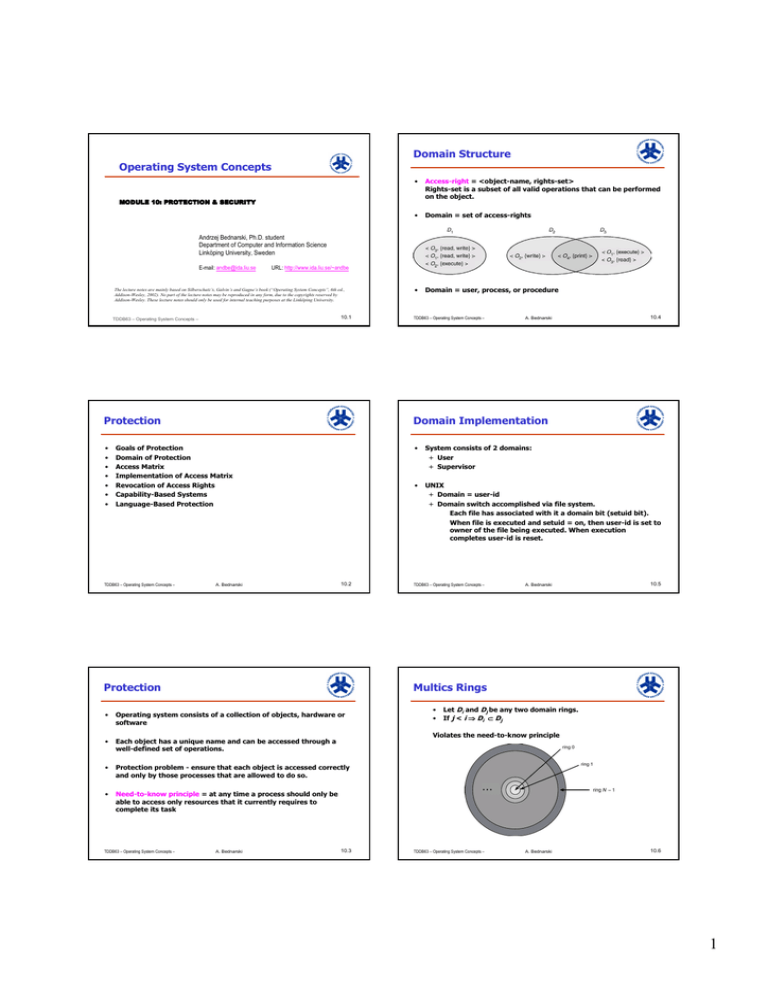
Domain Structure Operating System Concepts • Access-right = <object-name, rights-set> Rights-set is a subset of all valid operations that can be performed on the object. • Domain = set of access-rights • Domain = user, process, or procedure MODULE 10: PROTECTION & SECURITY Andrzej Bednarski, Ph.D. student Department of Computer and Information Science Linköping University, Sweden E-mail: andbe@ida.liu.se URL: http://www.ida.liu.se/~andbe The lecture notes are mainly based on Silberschatz’s, Galvin’s and Gagne’s book (“Operating System Concepts”, 6th ed., Addison-Wesley, 2002). No part of the lecture notes may be reproduced in any form, due to the copyrights reserved by Addison-Wesley. These lecture notes should only be used for internal teaching purposes at the Linköping University. 10.1 TDDB63 – Operating System Concepts – TDDB63 – Operating System Concepts – A. Bednarski 10.4 Protection Domain Implementation • • • • • • • • System consists of 2 domains: + User + Supervisor • UNIX + Domain = user-id + Domain switch accomplished via file system. Each file has associated with it a domain bit (setuid bit). When file is executed and setuid = on, then user-id is set to owner of the file being executed. When execution completes user-id is reset. Goals of Protection Domain of Protection Access Matrix Implementation of Access Matrix Revocation of Access Rights Capability-Based Systems Language-Based Protection TDDB63 – Operating System Concepts – A. Bednarski 10.2 Protection A. Bednarski 10.5 Multics Rings • Operating system consists of a collection of objects, hardware or software • Each object has a unique name and can be accessed through a well-defined set of operations. • Protection problem - ensure that each object is accessed correctly and only by those processes that are allowed to do so. • Need-to-know principle = at any time a process should only be able to access only resources that it currently requires to complete its task TDDB63 – Operating System Concepts – TDDB63 – Operating System Concepts – A. Bednarski • • Let Di and Dj be any two domain rings. If j < i Di Dj Violates the need-to-know principle 10.3 TDDB63 – Operating System Concepts – A. Bednarski 10.6 1 Access Matrix Implementation of Access Matrix 1. Global table - Large, require I/O, grouping is limited 2. Each column = Access-control list for one object Defines who can perform what operation. Domain 1 = Read, Write Domain 2 = Read Domain 3 = Read 3. Each Row = Capability List (like a key) Fore each domain, what operations allowed on what objects. Object 1 – Read Object 4 – Read, Write, Execute Object 5 – Read, Write, Delete, Copy Figure 1 TDDB63 – Operating System Concepts – A. Bednarski 4. Lock mechanisms (lock and key) 10.7 TDDB63 – Operating System Concepts – A. Bednarski 10.10 Matrix with Domains as Objects Use of Access Matrix • If a process in Domain Di tries to do “op” on object Oj, then “op” must be in the access matrix. • Can be expanded to dynamic protection. + Operations to add, delete access rights. + Special access rights: owner of Oi copy op from Oi to Oj control – Di can modify Djs access rights transfer – switch from domain Di to Dj Figure 2 TDDB63 – Operating System Concepts – A. Bednarski 10.8 Use of Access Matrix (Cont.) • TDDB63 – Operating System Concepts – A. Bednarski 10.11 Access Matrix with Copyrights Access matrix design separates mechanism from policy. + Mechanism Operating system provides Access-matrix + rules. OS ensures that the matrix is only manipulated by authorized agents and that rules are strictly enforced. + Policy User dictates policy. Who can access what object and in what mode. TDDB63 – Operating System Concepts – A. Bednarski 10.9 TDDB63 – Operating System Concepts – A. Bednarski 10.12 2 Access Matrix With Owner Rights TDDB63 – Operating System Concepts – A. Bednarski Language-Based Protection 10.13 Modified Access Matrix of Figure 2 • Specification of protection in a programming language allows the high-level description of policies for the allocation and use of resources. • Language implementation can provide software for protection enforcement when automatic hardware-supported checking is unavailable. • Interpret protection specifications to generate calls on whatever protection system is provided by the hardware and the operating system. TDDB63 – Operating System Concepts – A. Bednarski 10.17 A. Bednarski 10.18 Security • • • • • • TDDB63 – Operating System Concepts – A. Bednarski 10.14 The Security Problem Authentication Program Threats System Threats Threat Monitoring Encryption TDDB63 – Operating System Concepts – Revocation of Access Rights The Security Problem • • • Security must consider external environment of the system, and protect it from: + unauthorized access. + malicious modification or destruction + accidental introduction of inconsistency. • Easier to protect against accidental than malicious misuse. • • • Immediate vs delayed Selective vs general + For some users or for all users Partial vs total + Subset of rights associated with an object Temporary vs permanent Capability List – Scheme required to locate capability in the system before capability can be revoked. + Reacquisition: periodic revocation of capabilities + Back-pointers: Each object maintains a list of pointer to all capabilities associated with that object + Indirection: indirect pointing to objects via a table (global) + Keys TDDB63 – Operating System Concepts – A. Bednarski 10.15 TDDB63 – Operating System Concepts – A. Bednarski 10.19 3 Authentication Threat Monitoring • User identity most often established through passwords, can be considered a special case of either keys or capabilities. • Check for suspicious patterns of activity – i.e., several incorrect password attempts may signal password guessing. • Passwords must be kept secret. + Frequent change of passwords. + Use of “non-guessable” passwords. + Log all invalid access attempts. • Audit log – records the time, user, and type of all accesses to an object; useful for recovery from a violation and developing better security measures. • Threat monitoring - Scan the system periodically for security holes; done when the computer is relatively unused. TDDB63 – Operating System Concepts – A. Bednarski 10.20 TDDB63 – Operating System Concepts – A. Bednarski Program Threats Threat Monitoring (Cont.) • Trojan Horse + Code segment that misuses its environment. + Exploits mechanisms for allowing programs written by users to be executed by other users. • • Trap Door + Specific user identifier or password that circumvents normal security procedures. + Could be included in a compiler. TDDB63 – Operating System Concepts – A. Bednarski 10.21 Check for: + Short or easy-to-guess passwords + Unauthorized set-uid programs + Unauthorized programs in system directories + Unexpected long-running processes + Improper directory protections + Improper protections on system data files + Dangerous entries in the program search path (Trojan horse) + Changes to system programs: monitor checksum values TDDB63 – Operating System Concepts – A. Bednarski 10.25 Network Security Through Domain Separation Via Firewall System Threats • Worms – use spawn mechanism; standalone program • Internet worm + Exploited UNIX networking features (remote access) and bugs in finger and sendmail programs. + Grappling hook program uploaded main worm program. • Viruses – fragment of code embedded in a legitimate program. + Mainly effect microcomputer systems. + Downloading viral programs from public bulletin boards or exchanging floppy disks containing an infection. + Safe computing. TDDB63 – Operating System Concepts – 10.24 A. Bednarski 10.22 TDDB63 – Operating System Concepts – A. Bednarski 10.26 4 Encryption • Encrypt clear text into cipher text. • Properties of good encryption technique: + Relatively simple for authorized users to encrypt and decrypt data. + Encryption scheme depends not on the secrecy of the algorithm but on a parameter of the algorithm called the encryption key. + Extremely difficult for an intruder to determine the encryption key. • Data Encryption Standard substitutes characters and rearranges their order on the basis of an encryption key provided to authorized users via a secure mechanism. Scheme only as secure as the mechanism. TDDB63 – Operating System Concepts – A. Bednarski 10.27 Encryption (Cont.) • Public-key encryption based on each user having two keys: + public key – published key used to encrypt data. + private key – key known only to individual user used to decrypt data. • Must be an encryption scheme that can be made public without making it easy to figure out the decryption scheme. + Efficient algorithm for testing whether or not a number is prime. + No efficient algorithm is know for finding the prime factors of a number. TDDB63 – Operating System Concepts – A. Bednarski 10.28 5
